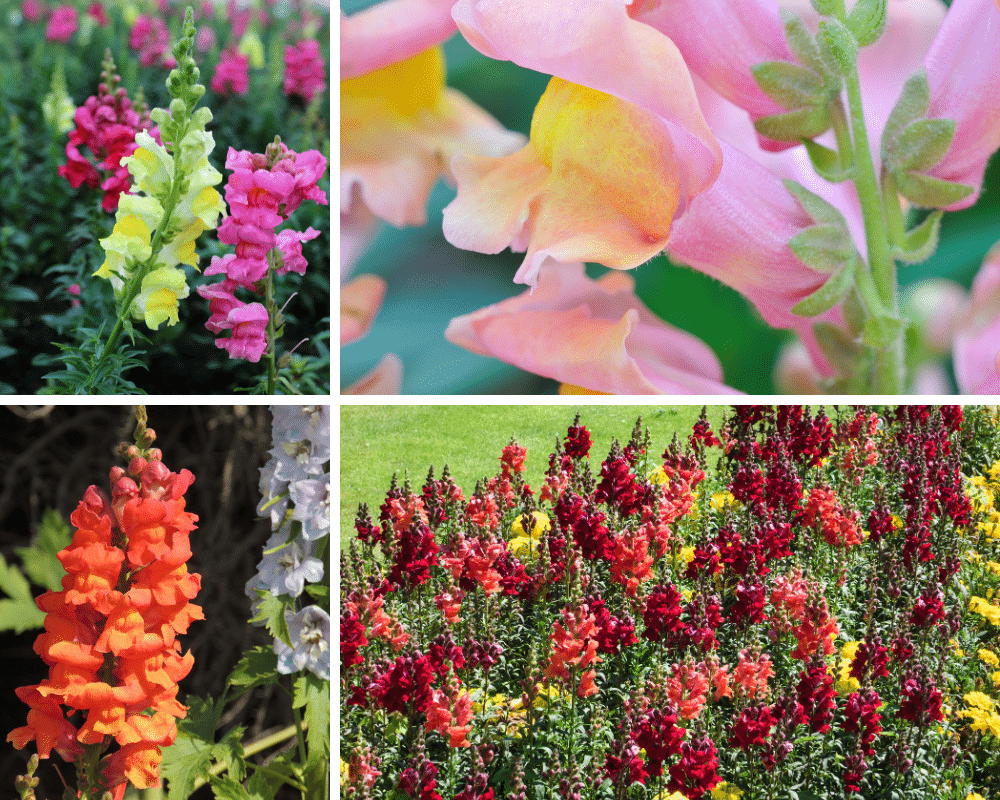How To Plant The Long Spikes of Puffy Petals?
The cooler days of summer are perfect for snapdragons. Made of long spikes of puffy petals, the snapdragon sports many colors, and flowers in spring or early summer and again in autumn. That’s useful! These are used as cool-season annuals. The flowers are actually short-lived perennials and in zones 8-11, they might bloom again, for you next year. Its botanical name is Antirrhinum majis which refers to looking like a nose or a snout!
Ways To Use The Snapdragon’s The Spire of Petals
There are certainly entertaining uses for this in your house and garden and maybe the medicine cabinet too.!
- Beds and borders
- Containers
- Window boxes
- Hanging baskets for the smaller varieties
- You can squeeze the flower “mouths” and amuse small children
- They are bitter but you can try them in salads
- The seeds will produce oil
- They have been used in medicine,
- Taller Snapdragons make an excellent background for lower plants, try a mounding shape in front of the spikes
- Deer do not like them, and you can use them on the edge of plants deer do like
How Did Snapdragons Get To Us?
We humans have a long history with Snapdragons. They were used in gardens of the Greek and Roman empires. And an ancient Greek physician wrote about beneficial uses for them. They are thought to be native to places in southern Europe, Russia, and North Africa. They may have been native in North America although we know that colonists brought their seeds with them.
Thomas Jefferson used cool season snapdragons in his “shrubbery”. Also, he left the earliest notes we have about the plant. What is a shrubbery? It’s a place to go for a quiet walk, enjoy nature, and avoid, for a few minutes, the business in the house. We find references to them in the writings of Jefferson, George Washington, Jane Austen, and of course Monty Python!
So, plant snapdragons in your “shrubbery” and you can be in very good company!
A Special Use For Snapdragons
In early spring, while cold days still prevail, we want to plant some bright annual flowers but few of our favorites are safe in that weather. The leading plants to put in first are cool season favorites, snapdragons, pansies, and dianthus. In our South Florida garden, they provide all winter color for us and we are glad to have them around.
Snapdragon Colors, Sizes and Varieties

You can expect to find snapdragons in every color except true blue. Look for color ranges from pale pastels to bright and some will be bicolor. The plant has a sentimental appeal for many people, put it where your guests will see it-they’ll appreciate it!
Varieties
Dwarf-6″-15″, these are dense and bushy- Try these with dianthus, dwarf plumbago, dusty miller, and vinca.
Look for these varieties: Candy Top and Snappy, each has multiple colors including bicolor versions. Also, Snaptini which is hardy to colder days. Snaptastic includes the bushy features of the dwarf varieties but with height.
Medium-try with geranium, marigold
Varieties: consider Liberty, Classic and Solstice
Large-30″-48′, try with geranium
Varieties: Maxumum is a tall variety (reaching four feet) and comes in many vivid colors. Also Madam Butterfly and Rocket.
Trailing snapdragons- there are now a few trailing varieties that are popular for hanging baskets
Trailing varieties: Cascadia, Luminaire, and Fruit Salad
Companion plants-select these for appearance as well as sun, soil, and water requirement compatibility.
The Best Way To Grow Cool Season Snapdragons?
Planting
Snapdragons appreciate a place with full or morning sun. Allow them six to eight hours depending on your climate. Plant them in moist soil amended with organic matter. Dig the hole twice the width of the plant container and as deep as it is. Place some time-release fertilizer in the bottom of the hole and gently remove the plant from its container so that the top of the plant is as high as the surrounding soil. Separate the plants 6″-12′ apart.
Water the plant well. You can leave a slight depression around the plant and consider the plant well-watered when that depression is full of water. A thorough watering will eliminate air holes and produce good root-to-soil contact.
Water daily for the first two weeks or so. As the plant grows, maintain moist but not soggy soil. After new growth begins you may begin a fertilizer program. Fertilize every four to six weeks. We find the liquid fertilizers that you apply with the hose effective and simple to use. Use a product designed for blooms that is convenient for you.
To Maximize Snapdragon Blooms
Remove dead blossoms, this encourages the plant to produce flowers instead of seeds. By about midsummer, the Snapdragon droops and loses blooms. This is the time to cut the stalks back by about 1/3 to 2/3 of their height. This will encourage a new bloom in early autumn.
A Midsummer (Hot Weather) Alternative
If you miss the spikes of color in the heat of summer, you can consider Angelonia. It is even called the ” summer snapdragon“. It provides the same spires of blooms and even a desirable scent. It does require less water.
Pests And Diseases
These are vigorous plants and are normally simple to deal with. But, “the best-laid plans”…
Virus- plants can have viruses and it is normally fatal. Destroy visible pests and damaged plants.
Leaf Spots, Rusts, and Powdery Mildew are unrelated problems but are treated the same way with fungicides. If this problem is repeated the plants may need to be planted farther apart to ensure airflow.
Anthracnose and blight-often fatal, you can use a copper fungicide. Destroy damaged plant material.
Insects such as aphids and whitefly-you will notice disfigured flowers and leaves. Insecticidal soaps may be helpful. Start by removing damaged leaves and those on which you see insects.
Here are links to 4 university articles on the Snapdragon.
